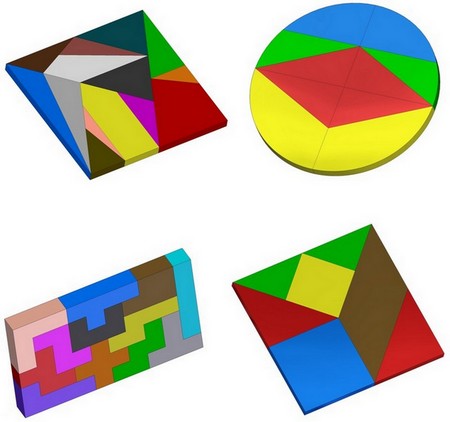Many dissection puzzles have been invented so far, and here we are presenting some of the most popular and well known puzzles.
Dissection puzzles (a transformation puzzles, tiling puzzles or Richter Puzzles) are the type of puzzles where solver has available tiles made by cutting some geometric shape, which can be rearranged into one or more distinct geometric shapes, using all available tiles without overlaps.
It means that given set of pieces can be assembled into at least two or more distinct geometric shapes. In other words, if we cut some geometric shape into smaller pieces which can be reassembled to form a new shape, we are talking about the dissection puzzles.
For each dissection puzzle we offer cutting diagram and tasks that need to be solved. The cutting diagram will help you either to make the puzzle by our dimensions or to scale it to desired dimensions. For most of the puzzles presented on these pages we gave solutions, but for few of them you need to find the solution on your own. You can find a number of various dissection puzzles on the internet or in the books, as well as various forms and figures that you can assemble. When you begin to play with these puzzles, you can also find many new forms and figures, or even develop a new type of these puzzles. Since active man's brain burns 20-25 percent of energy, you can look at the puzzle solving as a way to burn off excess energy.

Dissection puzzles are one of the oldest types of puzzles. The earliest known facts about dissection puzzles came from Ancient Greek and Chinese civilizations. The dissection puzzles owe great popularity to the newspapers, which began to publish various puzzles – including dissection puzzles – in the late 19th century. Today, they are used for entertainment, but since they are closely related to mathematics, the puzzles are also great for the educational purposes. They have educative value in such disciplines as combinatorics, geometry and programming, but one should not forget that they are also excellent for children, because they develop logical thinking and shape recognition.
Dissection puzzles are interesting when solved independently, but they are also excellent for social gaming, because they are interesting for competitions in speed solving.
Types of dissection puzzles
Dissection puzzles consist of geometric shapes cut out from one larger geometric shape. Depending on numbers of possible solutions, they are divided into two groups:
- those that can be assembled into multiple various shapes (Tangram, Stomachion of Archimedes, Pentominoes, Pythagoras puzzle...)
- those that have only one solution – one geometric shape that needs to be assembled (haberdasher's problem, Six pointed star puzzle, Letter dissection puzzles...)
Dissection puzzles are very easy to make. You can make them out of various materials, such as wood, plywood, metal, cardboard, plastic, acrylic, Plexiglas or some other material that is sturdy enough. To make dissection puzzle out of wood, you need only the basic hand tools (ruler, drafting compass, pencil, scissors, fretsaw, sandpaper...), some woodworking knowledge and a good will. Make sure to draw the cutting lines precisely and carefully cut the pieces. The more accurately you cut the pieces the better they will fit together.
How to make dissection puzzles
Draw the cutting lines on material from which you make puzzle according to our cutting diagram, or print cutting diagram on the paper and glue it on the workpiece. Carefully cut the pieces along the pattern lines. Make sure the pieces fit together well. If you make dissection puzzles of wood, sand surfaces thoroughly, smooth edges and put the varnish or paint on both sides.
Examples of dissection puzzles which you can make:
